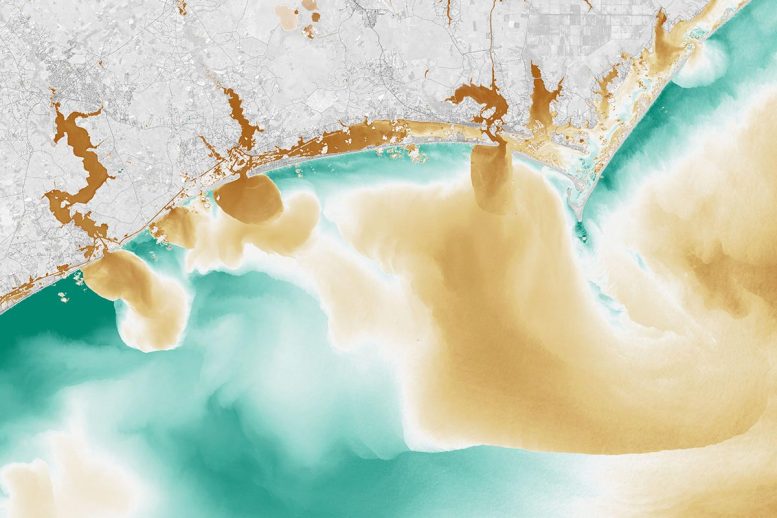Genetic Sequencing Reveals Surprising Origin of Floodwater Pathogens

A NASA image that combines visible and infrared data has disclosed the existence of dissolved organic matter, including potential antibiotic-resistant pathogens, in waters along coastal North Carolina following Hurricane Florence. Credit: NASA
New research has upturned prior assumptions about the origins of Salmonella pollution in North Carolina, suggesting that rivers and streams are the culprits rather than pig farms. This discovery calls for a revision of disease control methodologies.
The research, published in the Geohealth journal, suggests that the local streams and rivers were responsible for the widespread contamination of Salmonella enterica in coastal North Carolina following Hurricane Florence in 2018. Previously, it was thought that this contamination came from the high number of pig farms in the area.
The implications of these findings are significant for managing disease spread in the aftermath of flooding events, given their increased frequency in coastal regions of developing nations due to rising tropical storms.
Helen Nguyen, a professor at University of Illinois Urbana-Chamapaign and her graduate student Yuqing Mao, led the study. They traced the source of the S. enterica bacteria through genetic tracing in environmental samples from coastal North Carolina.
Yuqing Mao, with professor Helen Nguyen. Credit: UIUC
Nguyen mentioned that infections resulting from antibiotic-resistant pathogens lead to nearly 2.8 million human illnesses and 36,000 deaths annually in the U.S alone. Effective mitigation can prevent the global spread of such infections and reduce the strain they put on healthcare systems.
The researchers found that while flood waters often contain human and animal fecal genetic markers, attributing the spread of antibiotic-resistant bacteria to wastewater sources, septic systems, and livestock farms is not always accurate. No studies have definitively identified the source of such contaminants.
Nguyen suggested that coastal North Carolina is an exemplary case study area due to the concentration of pig farms, private septic systems, and frequent coastal flooding resulting from tropical storms.
Nguyen's team, three weeks post-Hurricane Florence, collected water samples from water bodies downstream of the swine farms in North Carolina. Out of the 25 samples collected, 23 tested positive for S. enterica bacteria.
Nguyen elaborated that their analysis of free-floating genetic markers revealed that the S. enterica bacteria in the samples were not derived from animals or manure. Instead, their origin was traced back to the numerous local rivers and streams in the region. This suggests that these pathogens are already prevalent in the natural environment.
Nguyen highlighted that the rising temperatures due to climate change, which facilitate bacterial growth and potentially increase the frequency and size of tropical storms, underscore the significance of their findings. She recommends that when mapping out plans to curb the spread of pathogenic bacteria post-hurricanes, both agricultural and human wastewater should be considered.
Nguyen's team plans to extend their research beyond coastal regions and is currently working with other researchers to study pathogen spread through geese feces in Illinois.
Reference's title is “Local and Environmental Reservoirs of Salmonella enterica After Hurricane Florence Flooding”. The authors are Yuqing Mao, Mohamed Zeineldin, Moiz Usmani, Antarpreet Jutla, Joanna L. Shisler, Rachel J. Whitaker, and Thanh H. Nguyen. The publication was on November 3, 2023, in GeoHealth. DOI: 10.1029/2023GH000877
Researchers from the Carl R. Woese Institute for Genomic Biology, the Carle Illinois College of Medicine, and the University of Florida also contributed to this study.
Support for this study came from The IGB, The Grainger College of Engineering, the Allen Foundation, and the EPA.




